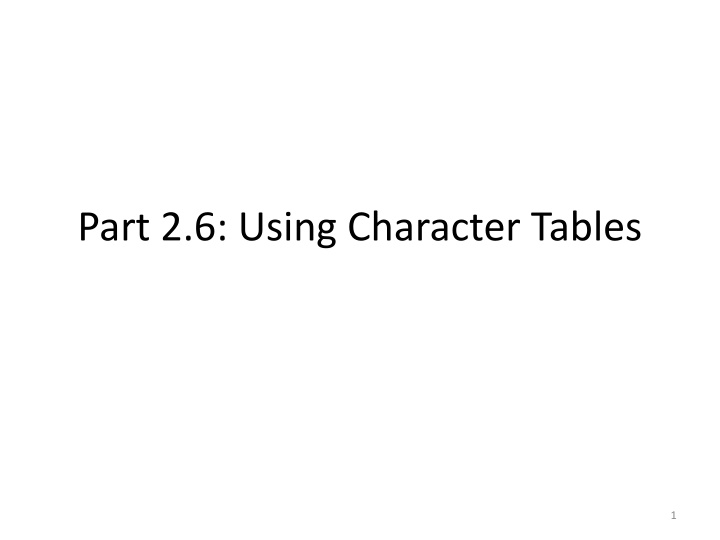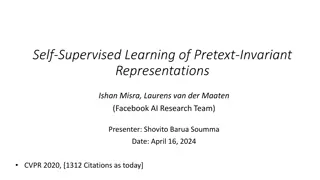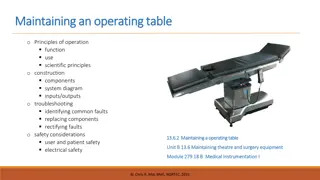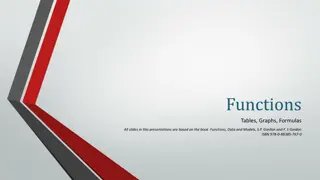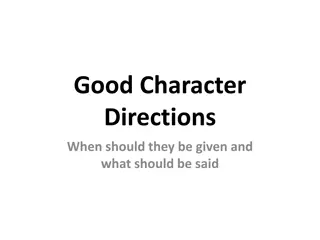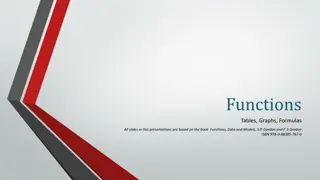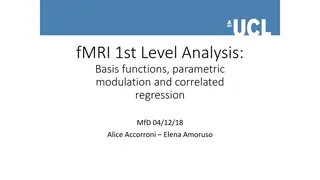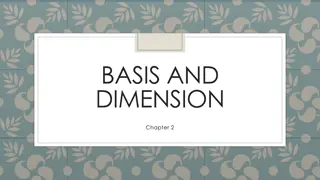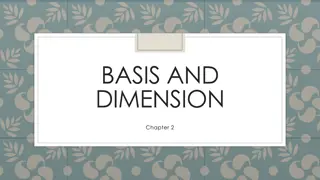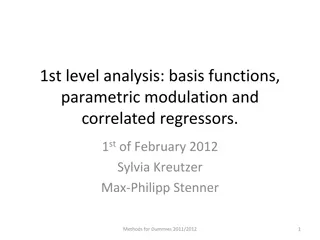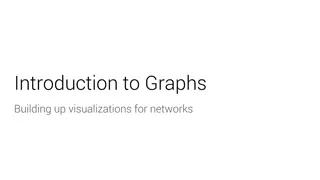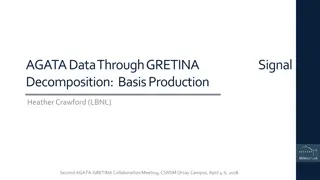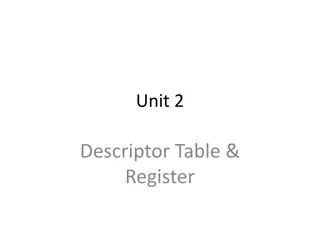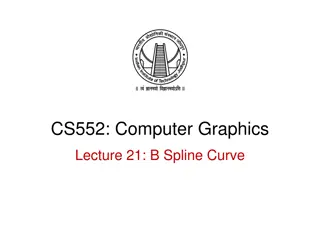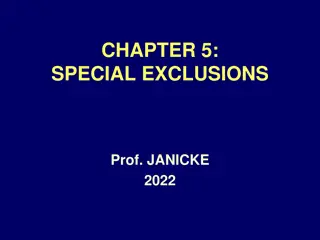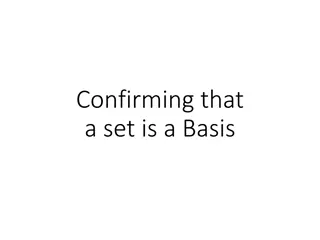Using Character Tables: Basis Functions & Representations
Using character tables for basis functions and representations involves understanding reducible and irreducible representations, direct products, and behaviors of basis functions under point group operations. The process includes decomposing reducible representations, diagonalizing characters, and employing inspection/trial and error methods. Explore the relationship between symmetry operations and group representations for molecules and materials.
Download Presentation

Please find below an Image/Link to download the presentation.
The content on the website is provided AS IS for your information and personal use only. It may not be sold, licensed, or shared on other websites without obtaining consent from the author.If you encounter any issues during the download, it is possible that the publisher has removed the file from their server.
You are allowed to download the files provided on this website for personal or commercial use, subject to the condition that they are used lawfully. All files are the property of their respective owners.
The content on the website is provided AS IS for your information and personal use only. It may not be sold, licensed, or shared on other websites without obtaining consent from the author.
E N D
Presentation Transcript
Using Character Tables Basis Functions Representations Reducible Irreducible Red. to Irr. Reps Examples N2H2 XeOF4 Direct Products Point Group? 2
Basis Functions How does (basis) behave under the operations of (point group)? For molecules/materials: atoms cartisian coordinates orbitals rotation direction bonds angles displacement vectors plane waves C3 3
Representations () Reducible Representation- A representation of a symmetry operation of a group, which CAN be expressed in terms of a representation of lower dimension. CAN be broken down into a simpler form. Characters CAN be further diagonalized. Are composed of several irreducible representations. Irreducible Representation- A representation of a symmetry operation of a group, which CANNOT be expressed in terms of a representation of lower dimension. CANNOT be broken down into a simpler form. Characters CANNOT be further diagonalized. 5
Representations () composed of several irreducible representations. i = a red i i Reducible Representation Irreducible Representations 6
Representations () Reducible to Irreducible Representations Irreducible Rep. Reducible Rep. 1) A lot of algebra 2) Inspection/Trial and Error 3) Decomposition/Reduction Formula 7
Representations () 2) Inspection/Trial and Error Reducible Rep. Reducible Rep. 1 = Ag + Bu 1 = A1 + B1 + B2 Irreducible Reps. Irreducible Reps. 8
Representations () 2) Inspection/Trial and Error Reducible Rep. 1 = 4Ag + 2Bg + 2Au + 4Bu Irreducible Reps. 9
Representations () 3) Decomposition/Reduction Formula aiis the number of times the irreducible rep. appears in 1 h is the order of the group N is the number of operations in class Q (R)Qis the character of the reducible representation i(R)Qis the character of the irreducible representation Cannot be applied to D h and C h 10
Representations () 3) Decomposition/Reduction Formula order (h) h = 1 + 1 + 1 + 1 = 4 1 = Ag + Bu 1 4 [ 4 4 ] (1)(2)(1) = 1 + (1)(0)(1) + (1)(0)(1) + (1)(2)(1) = aAg = 11
Representations () 3) Decomposition/Reduction Formula order (h) h = 1 + 1 + 1 + 1 = 4 1 = 4Ag + 2Bg + 2Au + 4Bu 12
Representations () 3) Decomposition/Reduction Formula order (h) h = 1 + 2 + 3 = 6 red = 2A1 + E 13
Or there is a website/spreadsheet http://symmetry.jacobs-university.de/ 14
Practice Irreducible Rep 1 2 6 0 2 2 2 6 4 6 2 0 1 3 0 -1 -3 0 1 15
Basis to Red. Rep to Irr. Rep. 1. Assign a point group 2. Choose basis function (bond, vibration, orbital, angle, etc.) 3. Apply operations -if the basis stays the same = +1 -if the basis is reversed = -1 -if it is a more complicated change = 0 4. Generate a reducible representation 5. Reduce to Irreducible Representation No matrix math is necessary! 16
Example: N2H2 1. 2. 3. Assign a point group Choose basis function Apply operations -if the basis stays the same = +1 -if the basis is reversed = -1 -if it is a more complicated change = 0 C2h N-H bond length ( r) E: 1 + 1 = 2 C2: 0 + 0 = 0 i: 0 + 0 = 0 h: 1 + 1 = 2 C2h operations: E, C2, i, h 17
Example: N2H2 1. 2. 3. Assign a point group Choose basis function Apply operations -if the basis stays the same = +1 -if the basis is reversed = -1 -if it is a more complicated change = 0 Generate a reducible representation C2h N-H bond length ( r) 4. E: 1 + 1 = 2 C2: 0 + 0 = 0 2 0 0 2 i: 0 + 0 = 0 h: 1 + 1 = 2 18
Example: N2H2 1. 2. 3. Assign a point group Choose basis function Apply operations -if the basis stays the same = +1 -if the basis is reversed = -1 -if it is a more complicated change = 0 Generate a reducible representation Reduce to Irreducible Representation C2h N-H bond length ( r) 4. 5. 2 0 0 2 Irreducible Rep. 19 Reducible Rep.
Example: N2H2 Decomposition/Reduction Formula order (h) h = 1 + 1 + 1 + 1 = 4 1 = Ag + Bu 1 4 [ 4 4 ] (1)(2)(1) = 1 + (1)(0)(1) + (1)(0)(1) + (1)(2)(1) = aAg = 20
Example: N2H2 1. 2. 3. Assign a point group Choose basis function Apply operations -if the basis stays the same = +1 -if the basis is reversed = -1 -if it is a more complicated change = 0 Generate a reducible representation Reduce to Irreducible Representation C2h N-H bond length ( r) 4. 5. 1 = Ag + Bu The symmetric aspects of r1 and r2 can be described by Ag and Bu irreducible representations. 21
Example: XeOF4 1. 2. 3. Assign a point group Choose basis function Apply operations -if the basis stays the same = +1 -if the basis is reversed = -1 -if it is a more complicated change = 0 C4v F atoms C4v operations: E, C4, C2, v , v 22
Example: XeOF4 1. 2. 3. Assign a point group Choose basis function Apply operations -if the basis stays the same = +1 -if the basis is reversed = -1 -if it is a more complicated change = 0 Generate a reducible representation C4v point group F atoms 4. 23
Example: XeOF4 1. 2. 3. Assign a point group Choose basis function Apply operations -if the basis stays the same = +1 -if the basis is reversed = -1 -if it is a more complicated change = 0 Generate a reducible representation Reduce to Irreducible Representation C4v point group F atoms 4. 5. 24 Irreducible Rep. Reducible Rep.
Example: XeOF4 Decomposition/Reduction Formula order (h) h = 1 + 2 + 1 + 2 + 2 = 8 = A1 + B1 + E 1 8 [ =8 ] (1)(4)(1) + (2)(0)(1) + (1)(0)(1) + (2)(2)(1) + (2)(0)(1) = 1 aA1 = 8 25
Example: XeOF4 1. 2. 3. Assign a point group Choose basis function Apply operations -if the basis stays the same = +1 -if the basis is reversed = -1 -if it is a more complicated change = 0 Generate a reducible representation Reduce to Irreducible Representation C4v point group F atoms 4. 5. = A1 + B1 + E The symmetric aspects of F atoms can be described by A1, B1 and E irreducible representations. 26
Using Character Tables Basis Functions Representations Reducible Irreducible Red. to Irr. Reps Examples N2H2 XeOF4 Direct Products Point Group? 27
Direct Products Direct product: The representation of the product of two representations is given by the product of the characters of the two representations. 28
Direct Products Direct product: The representation of the product of two representations is given by the product of the characters of the two representations. Used to determine the: - representation for a wave function - ground and excited state symmetry - allowedness of a reaction -determining the symmetry of many electron states - allowedness of a vibronic transition - allowedness of a electronic transition 29
Direct Products Direct product: The representation of the product of two representations is given by the product of the characters of the two representations. The direct product of two irreducible representations will be a new representation which is either an irreducible or a reducible representations. 30
Direct Product General Rules The product of any singly degenerate representation with itself is a totally symmetric representation The product of any representation with the totally symmetric representation is totally symmetric representation Totally symmetric representation = A, A1, Ag, A1g, etc. 31
Direct Product Tables D h 33
Direct Products Direct product: The representation of the product of two representations is given by the product of the characters of the two representations. Used to determine the: - representation for a wave function - ground and excited state symmetry - allowedness of a reaction -determining the symmetry of many electron states - allowedness of a vibronic transition - allowedness of a electronic transition 34
Using Character Tables Basis Functions Representations Reducible Irreducible Red. to Irr. Reps Examples N2H2 XeOF4 Direct Products Point Group? 35
